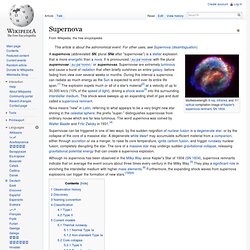

Mini-Supernova Discovered. Supernova. A supernova (abbreviated SN, plural SNe after "supernovae") is a stellar explosion that is more energetic than a nova.

It is pronounced /ˌsuːpəˈnoʊvə/ with the plural supernovae /ˌsuːpəˈnoʊviː/ or supernovas. Supernovae are extremely luminous and cause a burst of radiation that often briefly outshines an entire galaxy, before fading from view over several weeks or months. During this interval a supernova can radiate as much energy as the Sun is expected to emit over its entire life span.[1] The explosion expels much or all of a star's material[2] at a velocity of up to 30,000 km/s (10% of the speed of light), driving a shock wave[3] into the surrounding interstellar medium.
This shock wave sweeps up an expanding shell of gas and dust called a supernova remnant. Nova means "new" in Latin, referring to what appears to be a very bright new star shining in the celestial sphere; the prefix "super-" distinguishes supernovae from ordinary novae which are far less luminous. Discovery[edit] New Type of Star Explosion Discovered.
Astronomers have discovered a new kind of supernova, a star explosion so weak that scientists dubbed it a miniature stellar blast.

Supernovas represent the deaths of stars, which collapse in powerful explosions. They generally are classified into two main types; the new class, called Type Iax, "is essentially a mini-supernova," said lead researcher Ryan Foley, an astronomer at the Harvard-Smithsonian Center for Astrophysics. "It's the runt of the supernova litter. " Supernovas are the most powerful stellar explosions known to science, visible all the way to the edge of the universe. The first of the two main flavors, Type Ia supernovas, happen after a white dwarf star dies from siphoning off too much mass from a companion star. In 2002, researchers began noticing that many supernovas appeared to be similar to regular Type Ia supernovas, but were distinctly fainter.
"This really is a new kind of stellar explosion," Foley told SPACE.com. What Is A Supernova? A blindingly bright star bursts into view in a corner of the night sky — it wasn't there just a few hours ago, but now it burns like a beacon.

That bright star isn't actually a star, at least not anymore. The brilliant point of light is the explosion of a star that has reached the end of its life, otherwise known as a supernova. Supernovas can briefly outshine entire galaxies and radiate more energy than our sun will in its entire lifetime. They're also the primary source of heavy elements in the universe. According to NASA, supernovae are “the largest explosion that takes place in space.” Space Photography Space Telescopes & Astronomy. Supernova Star Explosion Origins Found. The key to a supernova's future is in its past, scientists say.

A new study, unveiled today (March 7), may help astronomers turn back the clock on supernovas to understand how some of these massive cosmic explosions, which signal the death of stars, can occur. By reviewing observations of 188 supernova remnants, study leader Xiaofeng Wang, an astronomer at Tsinghua University in Beijing, and his team discovered a seemingly simple way to understand what the "progenitor" star of a stellar explosion may have looked like before the white dwarf went supernova. Wang and his team focused specifically on a kind of star explosion known as a Type 1a supernova, which astronomers use as cosmic mile-markers to measure vast distances across galaxies.
New class of supernova identified by astronomers. Please support our site by enabling javascript to view ads.

Astronomers from the United States say they've discovered a new class of supernova that doesn't fit in the two previously known categories. The new class of supernova has been dubbed Type Iax. Astronomers had previously divided supernovae into two types, known as core-collapse and Type Ia. Scientists discover a new class of mini-supernova.
Astronomers have found a new kind of miniature supernova so comparatively small that some only shine a hundredth as brightly as their more common cousins.

The newly-discovered stellar explosion is called a Type Iax supernova, and while the team that made the discovery still isn’t exactly sure what causes it, they’ve already identified 25 examples of the phenomenon, reports Space.com. The white dwarf can actually survive the explosion Like standard Type Ia supernovas, the new Type Iax variety also happen in binary systems, in which a white dwarf and companion star are locked in orbit around a common center of mass, and in both cases the white dwarf explodes. But surprisingly, in Type Iax supernovas the white dwarf can actually survive the explosion. "The star will be battered and bruised, but it might live to see another day," said lead researcher Ryan Foley. It turns out that the new supernovas aren’t that rare, they’re just so faint that no one has noticed them until now.
Whoa! Mini-supernovas discovered. Astronomers have discovered a new kind of supernova, a star explosion so weak that scientists dubbed it a miniature stellar blast. Supernovas represent the deaths of stars, which collapse in powerful explosions. They generally are classified into two main types; the new class, called Type Iax, "is essentially a mini-supernova," said lead researcher Ryan Foley, an astronomer at the Harvard-Smithsonian Center for Astrophysics.
New kind of `mini` supernova discovered. Astronomers Discover 'Mini Supernova' Hiding In The 'Shadows' Of The Universe.